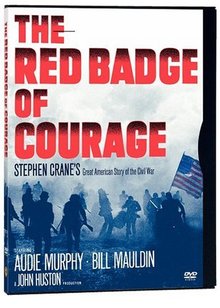| The Red Badge of Courage is a John Huston Civil War classic starring Audie Murphy and Bill Mauldin (yes, the WWII creator of the “Willie and Joe” cartoons). Barely over an hour long, the movie pretty much sticks to Stephen Crane’s novel and features multiple passages read outloud by the film’s narrator. While clearly a war movie about “courage”, I found the most interesting embedded message here to be about the untested soldier Henry Fleming’s struggles to match his confidence and self-image with what he wanted it to be or hoped it could be and with his perception of the expectations of others. Battle happens to be the ready setting for this story, but the essential conflict could have been depicted in many ways.
At the beginning of the story Fleming and his Union comrades in arms have never been in battle and are bored with military life and useless drilling. Itching to fight (each other if they can’t get at the Rebels) the men talk boisterously of the feats they will perform under fire and young Fleming joins in while alternately withdrawing into his doubts. He struggles because he’s afraid he will be afraid, and because the realization of his fear appears to confirm the worst. Yet he doesn’t want to consider himself a coward, or be considered a coward by his fellow troops or his family. He speaks and writes in ways meant to show that he will stand firm, but he has to question himself. |
 |
Battle looming or not, untested young men have to deal with the same concerns and hope they will rise to be among the best while fearing they will be among the worst, and the fear of failure can be more motivating than the fear of death itself. This movie is a good opportunity to look at the nature of courage, the influence of others around us in inspiring our best or most craven characteristics, and even to examine the role of faith in giving us a workable handle for grabbing hold of the world. It is also good preparation for young men (or older men) who have not been tested so that they know their doubts or thoughts are not unique to them.
Point to Ponder:
After the Rebels’ first brief attack and retreat, and then after the last battle, Fleming and the others saw the world – and appreciated things – in a different way. Imagine yourself in those same moments; how would you describe the sensation?
Questions to ask:
- Fleming was embarrassed first to have run, and then embarassed to be recognized for his fighting. Why do you think both were embarrassing to him?
- What was the philosophy of the “happy soldier” (played by Andy Devine) that Fleming met the night after the first battle? Did this have an affect on Fleming?
- Was it courage or another kind of fear that propelled Fleming into battle on the second day?
- What effect did the actions of the soldiers who ran and the soldier’s who stayed and fought have on Fleming? What consequences did his actions have on others on the first day and then on the second? Which behavior do you think was closest to his true character?
- The narrator said, “He had performed his mistakes in the dark so he was still a man.” If nobody sees what you do does it make a difference?
- Even when Fleming confessed the truth to his friend he couldn’t bring himself to tell the whole truth. Was this another kind of fear? How well did he confront and overcome this challenge? All in all, would you say he was brave, or a weasel, or something in between? Why?
Great quote:
“So it came to pass as he trudged from the place of blood and wrath his soul changed. He had been to touch the great death…and found that after all it was but the great death. Scars faded as flowers and the youth saw that the world was a world for him. He had rid himself of the red sickness of battle.”
About Fundamentals in Film: this series began as a class I taught to junior high and high school boys as a way to use the entertainment media to explore concepts of honor, honesty, duty and accountability. The movies were selected to demonstrate these themes and as a contrast to television that typically either portrays men as Homer Simpsons or professional wrestlers, with little in between those extremes. I wrote questions and points to ponder for each movie to stimulate discussion and to get the boys to articulate their thoughts and reactions to each movie. I offer this series here on this blog for the benefit of parents or others looking for a fun but sometimes challenging way to reinforce these concepts in their own families or groups. As the list of films grows each week, feel free to use these guides and to mix and match movies according to your interests or those of your group. I’m also always open to suggestions for other movies that can be added to the series.











